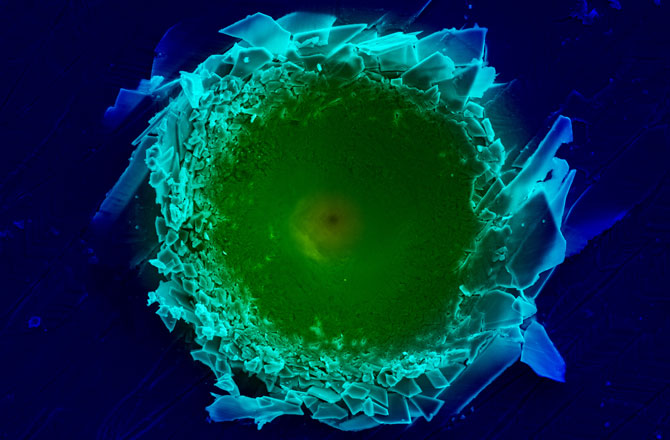
This colorized scanning electron micrograph shows a mollusk shell (Placuna placenta). Even when penetrated with a sharp object, the shell doesnt fracture.
Two new scientific papers in the last week describe ways to make new kinds of armor that take inspiration from humble mollusks: the abalone and the windowpane oyster. Researchers for both teams, one from France the other from MIT, say they don’t think it will be long before soldiers, and perhaps our cars, will be outfitted bio-inspired armor, windshields or heat shields.
“There is so much going on right now, the advances in the next decade are going to be incredible,” said Christine Ortiz, professor of materials science and engineering at MIT. Ortiz and graduate student Ling Li have a study in today’s edition of the journal Natural Materials describing experiments with a species of oyster (Placuna placenta) that has a shell that is 99 percent ceramic and 80 percent transparent. That’s a pretty good combination for a bullet-proof windshield, explained Ortiz.
“When we started doing mechanical tests we found it has multi-hit capability,” Ortiz said. And, unlike glass, when the researchers penetrated the oyster shell with a tiny sharp object, the shell didn’t fracture and the deformation was localized.
10 Materials that Emulate Nature: Photos
<!--[if !supportLineBreakNewLine]--> <!--[endif]-->
<!--[if !supportLineBreakNewLine]--> <!--[endif]-->
<!--[if !supportLineBreakNewLine]--> <!--[endif]-->
“For armor, nacre is the real standout for everyone,” Deville said from his lab in Cavaillon, France. “It’s so good for absorbing energy.”
Ninjabot Has Quick and Deadly Strike
Deville said his method would also work to make super-strong, heat-resistant materials inside high-speed vehicle or aircraft engines. Still, the biggest challenge to both teams is scaling up the work from the laboratory to factory, according to Marc Myers, professor of materials science at the University of California, San Diego, and a leading expert on bio-mimicry.
“How do you make it in larger parts?” Myers said. “Nacre does it very well. We’ve been playing around with this for more than 30 years. It’s still very challenging.”
 Attachment:
Attachment:
Copyright © 2024 International Society of Bionic Engineering All Rights Reserved
吉ICP备11002416号-1









